This article covers
What is Kingdom Animalia? A quick overview
All animals are members of the Kingdom Animalia (also called Metazoa). Animals are multicellular organisms that can move and consume other organisms for energy. It is estimated that around 9 or 10 million species of animals inhabit the Earth. Animals come in all kinds of sizes and shapes. So far, we have defined 31 known phyla, and several of them only exist in fossil records.

It’s hard to imagine that a sea star and a bald eagle are in the same kingdom, but they share certain characteristics that land them together:
(1) Eukaryotes, which have true nuclei in animal cells. Eukaryote cells are more complex than the simpler prokaryote cells found in bacteria.
(2) Multicellular, which means that they are made up of more than one cell.
(3) Heterotrophic, which means they can’t produce their own food. Members of the Animalia Kingdom must ingest, or eat other organisms.
(4) No cell wall: plants, fungi, and prokaryote cells have a cell wall, which is a rigid outer layer that gives cells structure. Animal cells do not have this structure. As a result, animal cells are more flexible to change their shapes and movements.
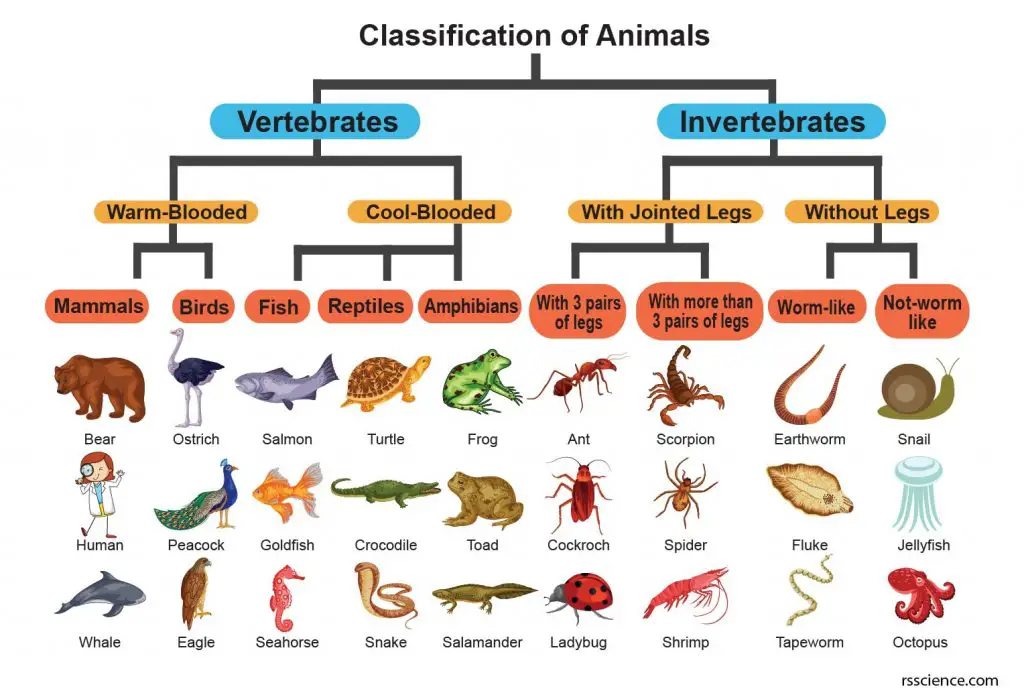
[In this image] A hierarchical tree to classify the diverse members of animals.
This diagram only shows a very little part of the Kingdom Animalia. However, you still can see how we group them by the features of their body plans. You will learn how scientists sort these creatures professionally later in this article.
In this article, you will learn more about the characteristics and diversity of Kingdom Animalia. You will also see many examples of different animal types. You will learn how taxonomists (biologists that group organisms into categories) classify these creatures systematically, like the orders of books in a library.
Part 1. Characteristics of animal cells
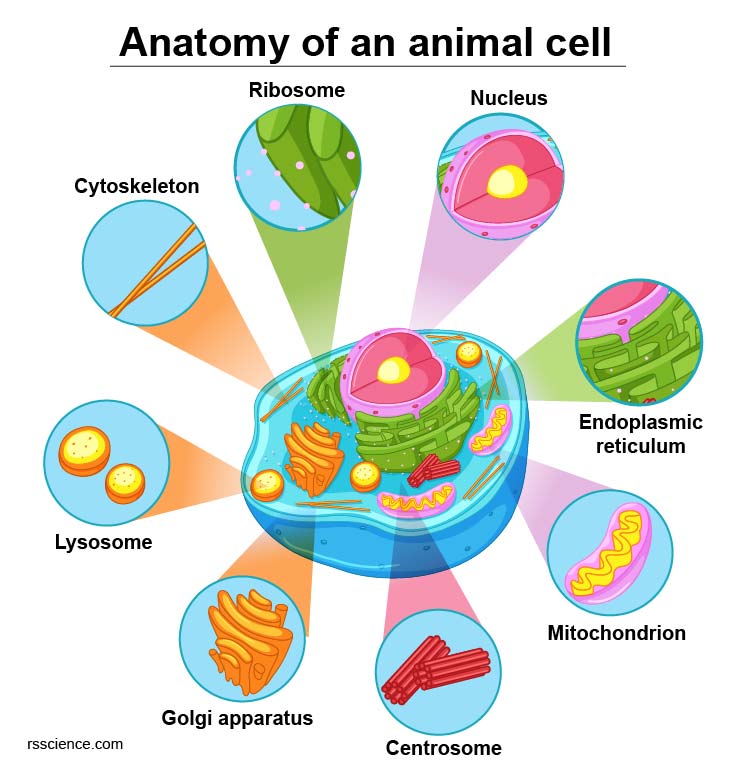
[In this figure] Diagram of an animal cell.
It has cell organelles, including the nucleus, mitochondria, ribosomes, endoplasmic reticulum, Golgi apparatus, lysosome, centrosome, peroxisome, and cytoskeleton. However, animal cells do not have a cell wall, chloroplasts, and big vacuole.
Animal cells lack the rigid cell walls
Like different organs within the body, animal cells include various components known as cell organelles that perform different functions to sustain the cells as a whole. Compared to plant and fungus cells, animal cells don’t have cell walls. As a result, most animal cells are round and flexible, whereas most plant cells are rectangular and rigid. Except for a few animals, most animals are motile, allowing them to respond to stimuli, find food, and reproduce effectively.
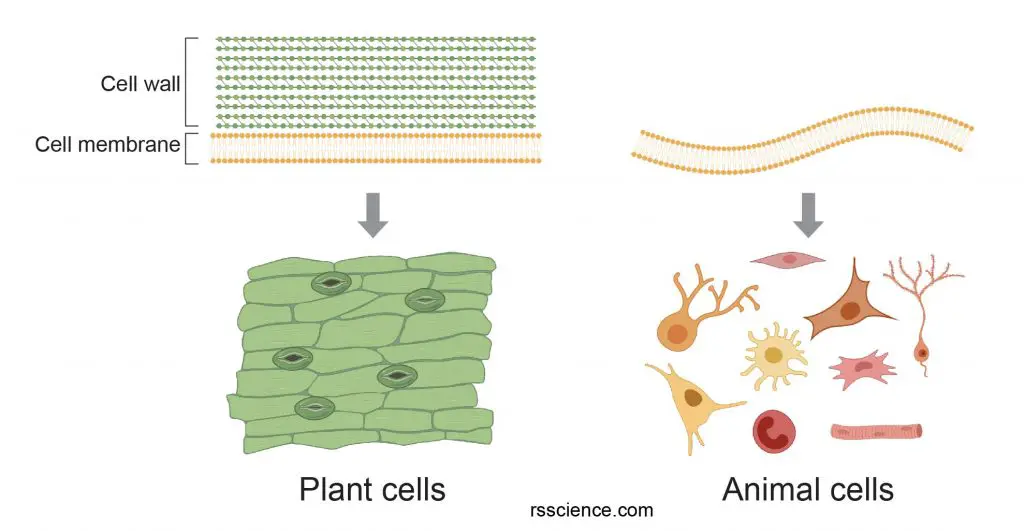
[In this figure] Cell walls provide additional protective layers outside the cell membranes.
Animal cells live as heterotrophs
Another major difference is that animal cells only have mitochondria, whereas plant cells have both mitochondria and chloroplasts. Mitochondria function like the powerhouses in the cells and convert sugars into biological energy called ATP. On the other hand, chloroplasts absorb sunlight and convert CO2 and water into sugars and oxygen. For this reason, animals are all Heterotrophs, meaning they cannot produce their own food. Instead, animals take nutrition from other sources. Most ingest food and digest it in an internal cavity.
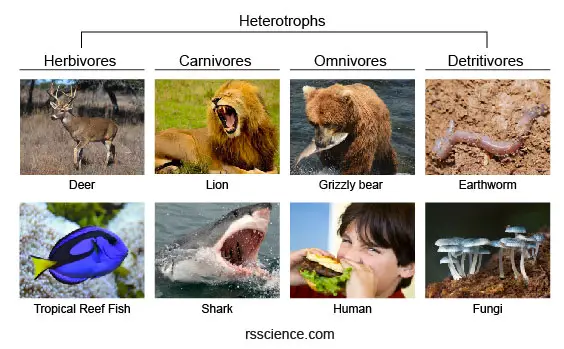
[In this image] Animals are all heterotrophs.
Based on their relationship in a food chain, heterotrophs can be further classified as herbivores (eat plants), carnivores (eat meat), omnivores (eat both plants and meat), and detritivores (decompose the remains of plants and animals).
Animal bodies are assembled by many cells
All animals are multicellular organisms. Their bodies are built by cells (as building blocks) following a blueprint (written in the genome). Unlike single-cellular organisms that one cell needs to do everything, animal cells specialize into many types so each cell type can focus and master certain functions. For example, heart muscle cells focus on beating, and brain cells focus on memory and thinking.
The bodies of most animals (except sponges) are made up of cells organized into tissues. Each tissue specializes to some degree to perform specific functions. Often, tissues organize into even more specialized organs.
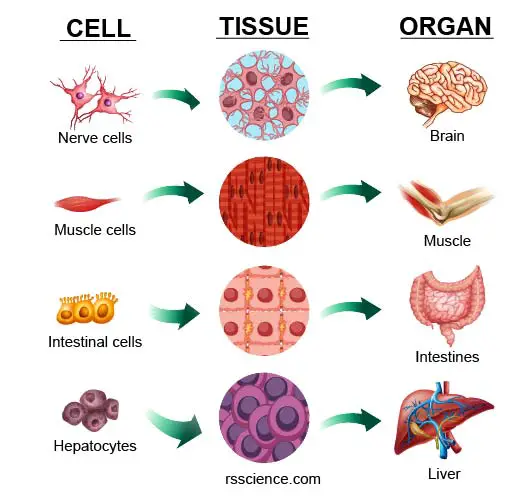
[In this image] The organization of cells into tissues, and then into organs, in multicellular organisms.
Animals can move around and reproduce sexually
Most animals can move compared to plants and fungi. They reproduce sexually by means of differentiated eggs and sperms. Most animals are diploid (2n), meaning that the cells contain two copies of the genetic material.
The development of most animals follows distinctive stages, including a zygote, formed by the product of the first few divisions of cells after fertilization; a blastula, which is a hollow ball of cells formed by the developing zygote; and a gastrula, which is formed when the blastula folds in on itself to form a double-walled structure with an opening to the outside, the blastopore.
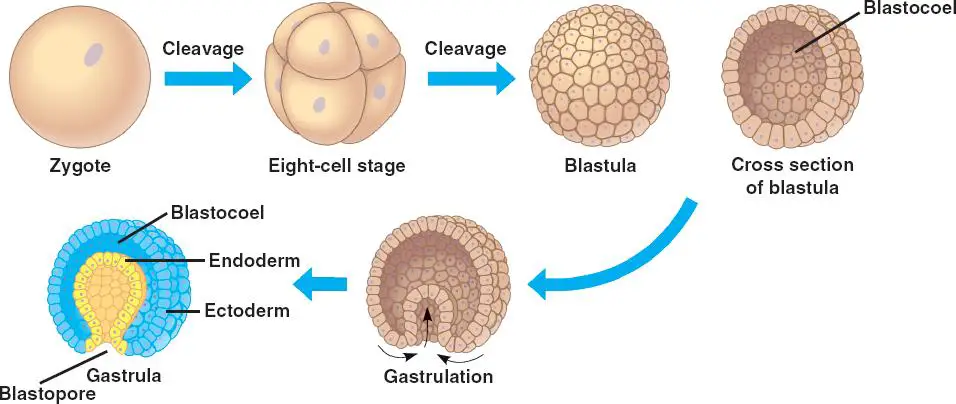
[In this image] The process of early human embryonic development.
Most animals also follow the same process in the earlies stages of life.
Photo credit: Study.com
Part 2. How to classify all these animals with different shapes and sizes?
Huge diversity of animals
The Animalia Kingdom is vast, with many unique and fascinating organisms. It is estimated that around 9 or 10 million species of animals inhabit the Earth. The exact number is not known, and all estimates are rough. If you also consider extinct species and those only shown in fossils, the number could be 10,000 times more.
Animals range in size from no more than a few cells to the giants weighing several tons, such as blue whales and giant squid. By far, the most known species of animals are insects (1 million). Mollusks, crustaceans, and nematodes are also very diverse. By this measure, our own group, the vertebrates, is relatively inconsequential from a diversity perspective.
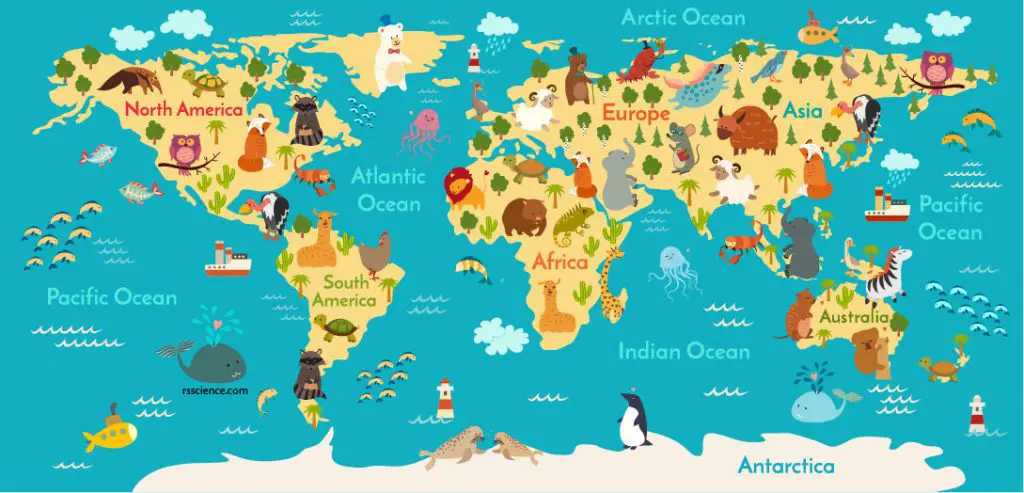
[In this image] A world map showing the diversity of animals.
Hierarchical classification of animals
In order for us to understand how all living organisms are related, we classified them into different groups. This hierarchical classification (called Taxonomy) helps us to place every organism in its unique place based on its evolution.
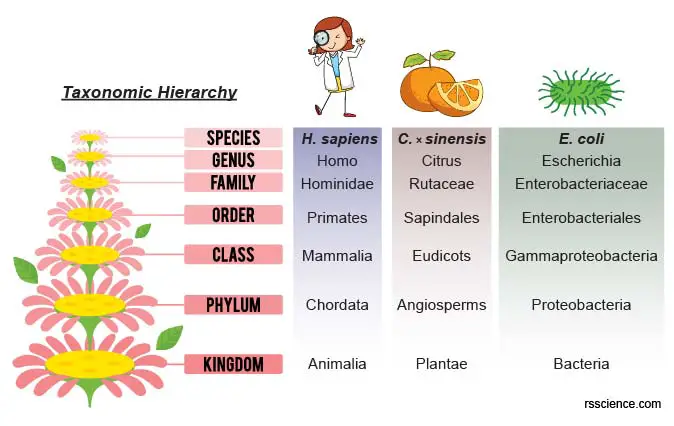
[In this image] Taxonomy, meaning “arrangement”, is the science of defining and naming groups of biological organisms on the basis of shared characteristics.
As you can see here, taxonomic rank has seven major levels – Kingdom, Phylum, Class, Order, Family, Genus, and Species. Under this system, each organism (here, human, orange, and a bacterium called E. Coli in our intestine) has its unique position.
The broadest level of biological classification is a Domain. As you can see in the image below, there are three Domains (Archaea, Bacteria, and Eukarya). Animalia is one of the Kingdoms that belong to the Domain Eukarya (meaning they are all made of eukaryotic cells).
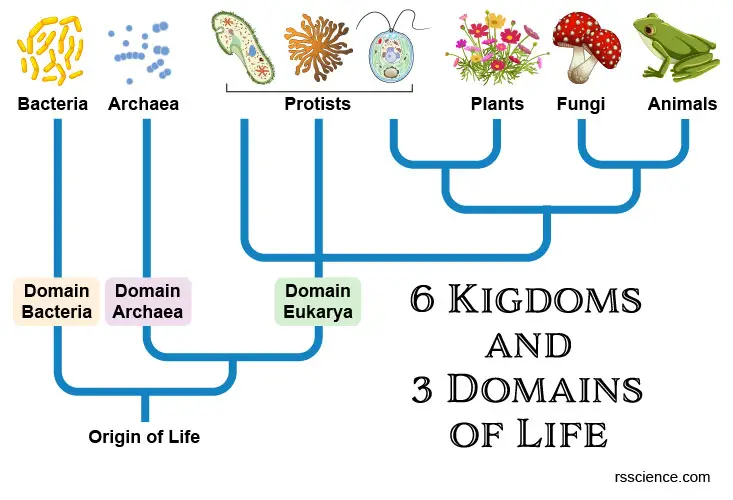
[In this image] There are three Domains (Bacteria, Archaea, and Eukaryote) and six Kingdoms (Bacteria, Archaea, Protists, Plants, Fungi, and Animals) that classify all the living organisms on Earth.
Learn more:
The level beneath Kingdom is the Phylum. At this level, you can see the major diversity of different animals. The Animalia Kingdom is divided into 31 phyla (plural form of phylum) by their main features. For example, animals that have a notochord, a hollow dorsal nerve cord (for humans, the spine), belong to the phylum Chordata.
Animals carrying a shell to protect their soft bodies are members of the phylum Mollusca. Insects and spiders have different numbers of legs, but both belong to the phylum Arthropoda due to their hard exoskeletons.
Earthworms, roundworms, tapeworms, and horsehair worms look very similar with a wire-like body. However, they are classified into phyla Annelida, Nematoda, Platyhelminthes, and Nematomorpha, respectively.

[In this image] These four kinds of legless “worms” in fact belong to four different phyla: Annelida, Nematoda, Platyhelminthes, and Nematomorpha.
Photo credit: wiki.
Note: The name of phylum is usually ending with “-a”, like Nematoda and Chordata. When we refer to the members in the phylum, “-a” is removed or changed to “-e”, like Nematodes and Chordates.
We will pick several main phyla to introduce their members in this article later.
Body plans of animals
Animals are classified according to morphological and developmental characteristics, such as their body plans.
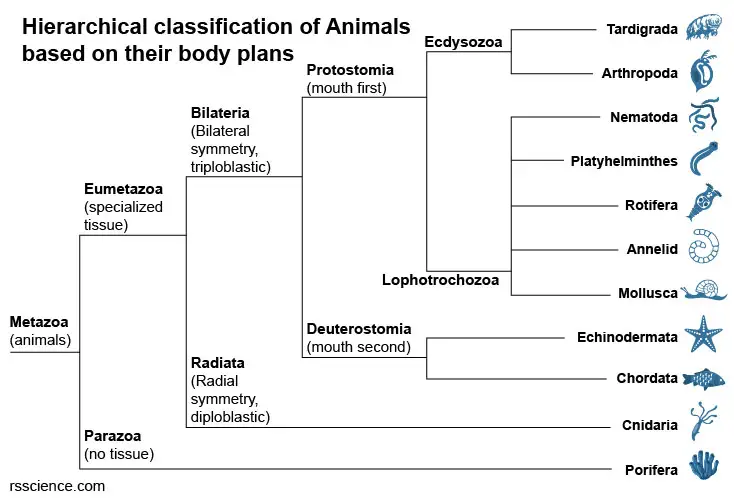
[In this image] The step-by-step process for scientists to classify the diverse members of animals into groups by the characteristics of their body plans.
(1) Body symmetry
Except for the most primitive animal group – phylum Porifera or the sponges, the remaining animal groups can be divided into radially and bilaterally symmetric animals.
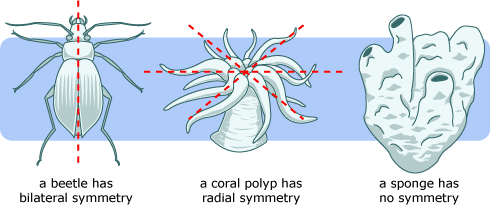
[In this image] Examples of animal body symmetry.
Photo credit: UC Museum of Paleontology Understanding Evolution
- Radially symmetrical animals are like phylum Cnidaria (jellyfish, corals, and sea anemones), phylum Echinoderm (sea stars, sea urchins), and phylum Ctenophora (comb jellies).
- Bilaterally symmetrical animals can be divided into matching halves by drawing a line down the center. All vertebrates, insects, flatworms, and many others are all bilaterally symmetrical.
(2) Layers of tissues
Most animal species undergo a layering of early tissues during embryonic development. These layers are called germ layers. Each layer develops into a specific set of tissues and organs.
- Radially symmetrical animals develop two germ layers, an inner layer (endoderm) and an outer layer (ectoderm). These animals are called diploblasts.
- Bilaterally symmetrical animals develop three germ layers: an inner layer (endoderm), an outer layer (ectoderm), and a middle layer (mesoderm). Animals with three germ layers are called triploblasts.
(3) Presence or absence of a body cavity
Symmetrical animals are further divided based on types of body cavities (or called coeloms). The body cavity is a fluid-filled cavity between the body wall and digestive tract. For instance, we have thoracic (contains heart, lungs), abdominal (digestive organs, spleen, kidneys), and pelvic (bladder, reproductive organs) cavities.
- Acoelomate is an animal that does not have a body cavity. Examples are flatworms (phylum Platyhelminthes). Acoelomates also lack a cardiovascular system and respiratory system and must rely on diffusion across their flat, thin bodies for gas exchange.
- Eucoelomate is an animal with a true body cavity. All vertebrates are in this group.
- Pseudocoelomate is an animal with a primitive type of body cavity (see image below for the difference). Roundworms (phylum nematode) and Gastrotrichs (phylum Gastrotricha) are examples.
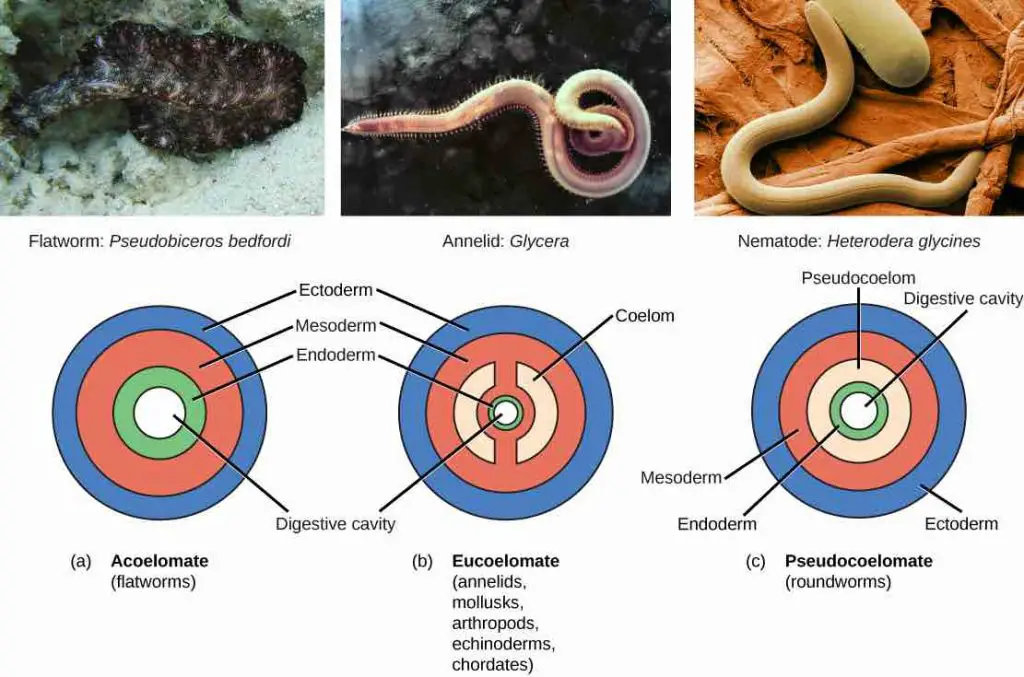
[In this image] Three types of body cavities.
Acoelomates have no body cavity. Eucoelomates have a body cavity within the mesoderm, called a coelom, which is lined with mesoderm tissue. Pseudocoelomates have a similar body cavity, but it is lined with mesoderm and endoderm tissue.
Photo source: openstax
(4) The order of mouth and anus
All the animals with a true body cavity can be further divided into two major groups. This difference reflects the fate of a structure called the blastopore, which becomes the mouth in protostomes and the anus in deuterostomes at early embryonic development.
- Protostomes include phyla such as Arthropoda (insects), Mollusca (shellfish), and Annelida (earthworms). The word protostome came from Greek words meaning “mouth first”. The blastopore becomes the mouth in protostomes.
- Deuterostomes include Echinodermata (sea stars) and Chordata (mammals). Deuterostome originates from words meaning “mouth second” (in this case, the anus develops first). The blastopore becomes the anus in deuterostomes.
Summary 1
1. Organisms in the Animalia Kingdom share these characteristics:
(1) Eukaryotes, which have true nuclei in animal cells.
(2) Multicellular, which means that they are made up of more than one cell.
(3) Heterotrophic, which means they can’t produce their own food. They must ingest, or eat, other organisms.
(4) No cell wall: plants, fungi, and prokaryote cells have a cell wall, which is a rigid outer layer that gives cells structure. Animal cells do not have this structure.
2. The level under the Kingdom Animalia is the Phylum. There are 31 known phyla, but several of them are extinct.
3. Members of the same Phylum are grouped together based on shared features of their body plans. The criteria could be, for instance, radical or bilateral symmetry, and the presence or absence of body cavities.

